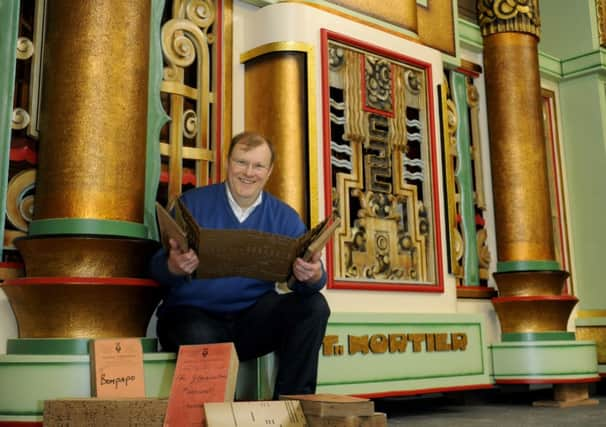Long before iTunes


IT’S the soundtrack of dreams of romance hung on invitations to dance, so resonant of a lost age that every note summons forth images of beaus in their best suits embracing sweethearts in crinoline.
The tune is the old Dean Martin staple Sway and it’s being belted out at strict tempo and thunderous volume, all trills and fanfares, so resonant that the couples who once swayed to it across a sprung parquet floor could feel the beat through the soles of their patent leather shoes.
Advertisement
Hide AdAdvertisement
Hide AdBut this is no ballroom, and there is no band. The music is filling a workshop in the middle of the countryside where there are no neighbours to disturb, its only audience two men captivated since childhood by the sound they are hearing.


“The great thing is,” says Andrew Pilmer, “That out here we can play what we want, when we want, any time of the day or night.”
Sway is being performed by a vast and fabulous musical machine in which art and craft are in perfect balance. It is a huge mechanical organ almost the size of a modest cottage, 25ft across and 16ft high, which once propelled dancers across the floor by reading thick books of perforated cardboard that unfold page by page into a complicated mechanism that translates each hole into a note.
High up on its ornate frontage, an accordion is apparently suspended in mid-air playing itself, the bellows working, its keys being played by the invisible fingers of the machinery.
Advertisement
Hide AdAdvertisement
Hide AdAt the rear sits a library of dozens upon dozens of the foot-thick cardboard books with enough music to keep the dancers happy all evening. There are different tempos – one-steps, polkas, waltzes – and the titles speak of an era when light classics and popular songs alike filled the floor – March of the Gladiators, Once in a While, selections from Strauss and Oklahoma.
There is nobody else in the country who knows as much about these books and the machines that play them as Andrew and his friend and workshop manager Russell Wattam. Between them, they have revived the sound of yesterday so it is once more thrillingly alive.
It has taken them well over a year to restore the organ, and soon they will face the task of dismantling it before accompanying it on the ferry from Hull to Holland, where they will reassemble it for its new owner, a collector.
The journey will be taking the instrument home. Holland and Belgium were the heartland of these organs, where for the first half of the 20th century they were installed in ballrooms and cafes, and travelled with fairs. They delivered the sound of an orchestra without the need for musicians, just a man round the back, feeding the cardboard books into the mechanism.
Advertisement
Hide AdAdvertisement
Hide Ad“It was simple economics,” said Andrew. “It doesn’t get tired, or stop to have a drink, and it’s cheaper than employing 10 musicians, and it played better than a small amateur band.”
But time caught up with them, and they came to be regarded as old fashioned. The cafes and ballrooms took them out, and they passed into the hands of collectors, though a single company, Decap, in Antwerp, continues to manufacture them and has a cordial relationship with Andrew.
This one, built in 1938 by the Mortier company, has been particularly well-travelled for such an unwieldy beast, starting life in a cafe in southern Holland, where it stayed until 1963, when an English collector took it across the Channel to Cornwall.
From there, it was sold to Switzerland, did a detour to Las Vegas, and then returned to England. Now its journey is about to go full circle, as its new owner is based in the south of the Netherlands. It will be a relatively short hop for Andrew and Russell, whose work takes them around the world maintaining machines that in many cases they have restored. In the United States, where the finest examples can change hands amongst collectors for well over a million dollars, they will visit several in a single trip.
Advertisement
Hide AdAdvertisement
Hide AdThe world beats a path to them, as well. Collectors and museums ship instruments to the workshop, near Rufforth, on the outskirts of York, to be unpacked, cared for and then dispatched back home.
It’s been this way since 1976, when Andrew, from Wakefield, was 17, and took the unusual career choice to carve out a living looking after machines that even then were archaic. His love affair with them had begun as a child, listening as they drew crowds with their music at fairs.
“The people who had them would see me standing and watching, see that I was interested, and show me how they worked,” said Andrew, 56. “And then I got involved in putting the cardboard music on to keep them going, while they went to the beer tent.”
And that’s how Russell, 48, from Huddersfield, also got started, with Andrew showing him the ropes. Andrew had also become interested in pianolas, the player pianos that use rolls punched with holes. “I started my own one-man business at 17-and-a-half. I say I’ve never had a proper job because I’ve never ever worked for anybody, only for myself.”
Advertisement
Hide AdAdvertisement
Hide AdIt was a challenge for a teenager in the 1970s to set about repairing instruments manufactured long before he was born. And what machinery it was – magnificent, ingenious, intricate and often baffling. Mistakes were made, but learned from as Andrew built his expertise.
“A big problem was – and is – that this business in effect died out with the Second World War and so the knowledge and skills were largely lost by the 1970s. We were all trying to find out how we did stuff, what materials to use, where you could source certain things and that was a difficult thing.
“It started out very modestly, but there was quite a lot to do, and the idea was if a harebrained scheme like this failed within 18 months, then I could still go to college, but that never came into question.
“We’re problem solvers now because jobs come along and almost every one brings something or other that you’ve got to find a way around.”
Advertisement
Hide AdAdvertisement
Hide AdAndrew found a market for his growing skills because collectors and museums had bought up organs dismantled in the cafes and ballrooms of the Low Countries. America was the prime destination, but in recent years enthusiasts in Europe have been bringing them back, and Andrew is the man they turn to when repairs and restoration are needed.
The musical machines still fascinate him. They have taken him to the Far East and Australia. They also brought him his partner, Susan, whose father owned one and called him in.
The collectors also call when they need new music to play, because Andrew arranges the tunes and manufactures the cardboard books that bring the instruments to life. Computer technology has caught up with that of the early 20th century with a programme that allows him to see what he is creating on screen instead of on a long piece of paper on a drawing board, which is how he started, but it remains painstaking work.
Every book is created by hand, the heavy cardboard being folded and glued to make it sturdy. And then Andrew sits down at a machine he devised himself – he began with a converted sewing machine – and hand-punches every single hole to make the performances sing.
Advertisement
Hide AdAdvertisement
Hide AdThis is music ordered by the length. He’s just completed a book that runs to 30 metres of cardboard and 15,000 holes, bound for Connecticut, and an order is in for two kilometres’ worth of new music, which means an awful lot of holes to be punched.
The workshop where he does it is filled with thousands of templates for tunes, new and old, but handled with care, the books he produces will last as long as the machinery that plays them.
“It’s a form that is very durable and very rugged, and it’s like a computer file in that it stores information. It is information technology in its early days,” added Andrew.
And as he stands in front of a massive fairground organ built in 1912 as it plays a stirring march, the ornate moving figures on the front ringing cymbals, Andrew has no doubt of the timelessness of this musical magic.
Advertisement
Hide AdAdvertisement
Hide Ad“What else can you buy that is still working and playing music after 102 years? You can’t get a Betamax tape for a video recorder, but you can still get cardboard music for a tune of your choice.
“When they go out, they still draw a crowd, you still see children standing in front and watching like I did. Some of the ones I saw when I was seven or eight years old, we now look after, and I’m proud of that.”
Andrew Pilmer’s company can be found at www.acpilmer.com